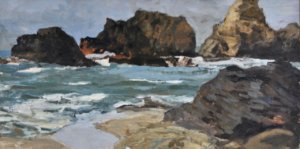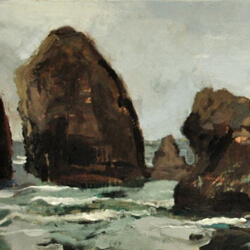Visual Arts Workshop
Beginning Oil & Acrylic Plein Air Landscape Workshop
with Jef Gunn
Saturday-Monday | October 10-12 | 9:00am-5:00pm
Tuition $450 | Materials $20
Manzanita, Oregon
The Hoffman Center for the Arts in Manzanita will offer
Beginning Plein Air Landscape Painting—a three-day
painting workshop
CANCELLED

Led by Portland artist, Jef Gunn, this beginning painting workshop is focused on painting the coastal landscape from direct observation in the open air. Nothing is quite as exhilarating as meeting our experience with our mind and hands in paint on a small rectangle. It is also a complex endeavor, so some guidance is necessary. Participants will learn about the materials and gear (paints, brushes, palette, and the plein air easel). Also, importantly: composition, color, paint mixing and handling, palette management, and the stages of building up a painting.
With this workshop, you will have a firm foundation in the essentials of painting and of painting the landscape en plein air. Plein air is simply French for “outdoors,” literally “full air” or “in the open air.” It has recently been taken to be a style. Jef Gunn does not see it as a style and says:
“I don’t actually care about styles. I do care about authenticity. Each painter paints as they see and feel. The more comfortable they become with the materials and their process, the more freely their feeling and vision can show up in their paintings. And that’s magic.”
Jef Gunn was born in Seattle in 1955 and grew up along the West Coast from Puget Sound to southern California and Hawaii. He studied drawing and painting in California through the 1970s, held residencies in Barcelona and Paris in the 1980s, and since the mid-1990s has engaged in a passionate study of Asian art. In 2005, Gunn completed a BFA in painting from Marylhurst University. He has taught art for 23 years, at various schools, including Pratt Fine Art Center, Seattle, Pacific Northwest College of Art and Oregon College of Art and Craft. He lives and works in Portland, Oregon, where he teaches painting classes and workshops at Sitka Center for Art and Ecology and through First Light Studio, his own Portland based studio.
With a balance of humor, broad knowledge, and helpful insight, he can draw from each student her or his own natural way to paint, while bringing to bear practical instruction through historical examples from many periods and cultures.
More information on Jef and his artwork
Materials
Paints: A full complement of the primaries (red, blue, yellow) warm and cool pigments of each. Each color has four dimensions, plus Titanium White, and a few Earth colors (yellow ochre, burnt sienna, raw or burnt umbre).
Hue (red, yellow, blue are primaries. Green, orange and violet are secondaries)
Value (darker or lighter)
Warm or Cool
Intensity or saturation (how pure the color is)
Examples of a balanced palette:
The Primaries:
Blues: ultramarine (warm) and cerulean (cool)
Reds: cadmium red medium or light (warm) and alizarin crimson (cool)
Yellows: cadmium yellow light (warm) and Hansa yellow (cool)
Note: cadmium yellow light is generally cooler than cadmium yellow medium, and cad yellow deep is even warmer.
Earth Colors: yellow ochre, raw or burnt sienna, burnt umber.
Note: Secondaries will be mixed from the primaries and this will be covered throughout the workshop.
(yellow + red = orange; yellow + blue = green; red + blue = violet)
Note: You can paint in oils or acrylics. Oils are the more versatile of the two. Especially painting outdoors in the sun and/or the wind. Acrylics dry fast and it is hard to manage the palette plus they require a cocktail of additives to keep them alive. Oils, once you get the hang of it, allow for very exciting paintings, in layers or wet in wet. This will be a cornerstone of our workshop, whether in acrylic or oils.
Brushes: hog bristle for oils. Synthetic for acrylics. You want at least 12 brushes of various sizes from No 2 to 10. Mostly, you will work with a 4, 6, 8 and 10. They come in flats, brights, filberts and rounds. I prefer flats and filberts. Bring a dozen or more if you can.
Medium: For plein air, a gel medium works well, either linseed or sunflower oil. Gamblin makes both and they are great. You do not need much.
Canvasses or panels: Plan on 2 per day in sizes 16 x 20, 12 x 16, or a narrow format, 10 x 20. Prime panels with pale gray, ochre, sienna, or brownish Gesso by stirring some liquid acrylic paint into the gesso.
Easel: Bring an easel that works outdoors. The best is a wooden ‘French’ easel with a paint box on legs and arms. A light-weight aluminum easel can work as well, but it can fly away in a breeze.
Other items you will want are:
Small container or solvent (or water for acrylics or watercolors). You can find stainless steel solvent pots with tight sealing lids at an art supply store.
A few palette knives, for mixing and for painting. Steel with wood handles, not plastic. (Plastic palette knives are not useful)
Rags
Cans or jars for solvent and medium. Two containers if using acrylic.
Lunch
Bag or backpack for carrying stuff.
More rags
Optional & Helpful items:
Pizza boxes to carry canvasses home. You can even tape or staple boxes together to make a file cabinet for paintings.
Medium. You do not need much, maybe none, but be prepared. A classic 3-part mix: 1-part stand oil 1-part damar varnish, 1-part odorless mineral spirit (Gamsol is great)
Galkyd or Liquin work great
For plein air, a gel medium works well: either linseed or sunflower oil
Sun hat, water bottle, (bug repellent, optional)
Rain hat, or wool hat, and jacket, just in case (fall is unpredictable)
Barrier crѐme for your hands
Waterless hand cleaner
Water bottle or thermos
Folding chair



